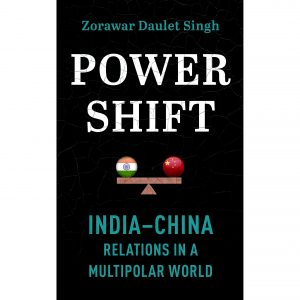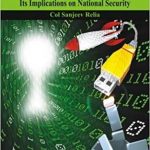
Border disputes between India and China have been a major reason for contention between the two major powers since the 1950s and have also contributed to making it one of the most critical bilateral feuds in the 21st century. Escalation of the disputes on the borders in the North and the North East of India have become common in recent years for the two giants, the Galwan clash of June 2020 being a prime example. The repeated escalations and lack of consensus on the border trickle down to other aspects of Sino-Indian relations and geopolitics as well. It depicts the precarious nature of the relationship between the two influential neighbours. With India and China at the front of the emerging world order, the equation between the two states affects not only Asia but Global politics, economics, and security. This makes it imperative for India to form strategies and policies to tackle the border disputes and its overall fraught relationship with China carefully to secure its global and regional standing, economy and security. Author, historian and strategist Zorawar Daulet Singh make a similar argument in his book – ‘Powershift: India–China Relations in a Multipolar World,’ published in 2020, by re-examining the history of their relationship and its current direction in a multipolar world. His book provides a strategic bilateral, regional, and global analysis of the various contributing aspects of the Sino-Indian ties with a focus on border disputes. In his analysis, he recommends a more evolved modus vivendi ‘where a gentler rivalry or competition is handled maturely’ while avoiding inhibition of the pursuit of common interests.
The book is divided into three different sections. The first section covers border disputes between the two states, the second section covers the effect of their relationship on world order and geopolitics. Lastly, the third section covers India’s strategy and policy analysis.
In the first section, the author explores the border dispute between the two states and its possible roots. He lays down various reasons in chronological order, starting from the British colonial legacy and the annexation of Tibet to India’s and China’s misperceptions of each other’s geopolitical issues and domestic strategies and the role of international players. The author tries to give an insight into the history of the border dispute and spends the majority of the section discussing the 1962 war and its aftereffects on the relationship between the two states. Despite Rajiv Gandhi’s 1988 visit bilateral meet and initiation of normalisation of bilateral ties, border skirmishes and tenacious negotiations have not been able to bear anything fruitful as the process continues to repeat.
Since the beginning of the skirmishes first in the 1950s, Singh believes that prime minister Nehru’s ‘soft’ diplomatic policies and negotiation stance, which led to the rejection of a proposed line of actual control (LAC), have continued to encourage China’s aggression. The Nehruvian style of diplomacy overestimated the desire of the other states to reach a common ground and therefore also overestimated the support from the Soviet Union and the United States to help ease the tensions between India and China to avoid the Sino-Indo war during the Cold War. However, the book also notes that the Nehruvian non-alignment foreign policy allowed India to find some convergence with its neighbour to create a balance of power in the subcontinent. Some notable examples of the same are the non-interference policy by the two states. China has mostly stayed silent on the Kashmir dispute despite being a close ally of Pakistan which has ultimately benefited India. On the other hand, India has stayed silent on a wide range of ‘internal’ Chinese issues, such as the Tiananmen Square incident.
Singh also explores the 2020 Ladakh standoff by examining the Chinese concern for the rising Indian infrastructure development near the LAC. Due to the fraught relationship between the two and the topographical benefits for India, the Chinese continue to grow more cautious and have an incentive to try and establish control over the sections of land they claim as their own.
The second and third sections of the book provide the readers with a better understanding of the current world order and global stability and the need for India’s policies and strategies to adapt to it. Both India and China have a shared approach towards the Washington Consensus globalisation world order, which differentiates them from the geopolitical culture of the western states and states like Japan. Through this, the book argues that the hegemonic stability theory does not explain the emerging world order as a complete transfer of power from the United States to China is unlikely. Irrespective of the tensions between the two powerful states, China and the United States caused due to their quest for dominance – economic interdependence and nuclear deterrence will always leave space for de-escalation.
The second section also puts an emphasis on the Belt and Road Initiative as a means of starting a strategic shift by a non-Western power. The initiative provides China with strategic power and influence through trade and geoeconomics development of the states involved throughout Eurasia. India, however, by opposing the initiative risks isolating itself in the subcontinent and getting surrounded by China’s ‘string of pearls’ while also putting locus on the short-term geopolitical benefits instead of the long term geoeconomics benefits and trading linkages that would eventually trump the geopolitical benefits. India still sees South Asia as an exclusive sphere of influence which is not a feasible venture.
After the Belt and Road initiative, the book further explains this shift in the world order through BRICS and the Quad. BRICS, an economic alliance between developing states which includes India and China, enhances China’s ability to shift the power in the world order more towards the East with China at the forefront and its sphere of influence spanning far beyond Asia, on the other hand, Quad, a military alliance that India is also a part of along with the United States, acts as a counterweight to the growing Chinese influence. These examples also depict India’s growing influence in the emerging world order, however, the author makes it clear that India cannot use its economic and military influence to push China in the desired direction due to the power asymmetry between the two states. India with its economic and military power gets an additional boost through leveraging its goodwill towards other states and diplomatic connections in comparison to China whose solipsistic diplomacy does not generate goodwill and rather gives rise to suspicion even among its allies. India with its considerable power and strong diplomatic connections needs to make realistic assessments to counter its neighbour. Singh writes that India needs to “formulate realpolitik policies that secure strategic interests without closing the door to cooperation and interdependence.” This can be achieved through constant engagement with China based on a cost-benefit analysis while building India’s national power through a multi alignment foreign policy that matches a multipolar world.
For geostrategy, however, the book compares India’s contrasting perspectives in the third section. Under Nehru, India followed a more Mahanian (Alfred Thayer Mahan) image that emphasises the need to control the oceans to increase strategic power. This view was borrowed after independence from an Anglosphere perspective, but according to the author, this strategy proves to be inaccurate under current circumstances where a Mackinder (Halford Mackinder) perspective of gaining continental space is more fruitful. According to the author, India cannot compensate for its continental geopolitics through maritime geostrategy. India’s military and naval presence can act as a “net security provider” in the Asia-Pacific region, which benefits India’s position to counter China’s power and increases its goodwill among other states in the region.
Singh’s book provides readers with a comprehensive synthesis of the relationship between the two Asian giants and their presence and effect on the world stage. The ties between India and China continue seeing heightened tensions as they compete on border disputes, matters of geopolitics and the changing world order. The book covers a wide range of these issues that have an impact on their bilateral and multilateral ties starting from India’s independence to the present time and argues from a rational and strategic perspective. Throughout the book, the author’s main argument echoes as a suggestion for the future of Sino-Indo relations at this critical juncture of time. The need for India to not constraint its strategy and policies in a single framework but rather act flexibly to match the multipolar world and maximise its interest while avoiding confrontation.













